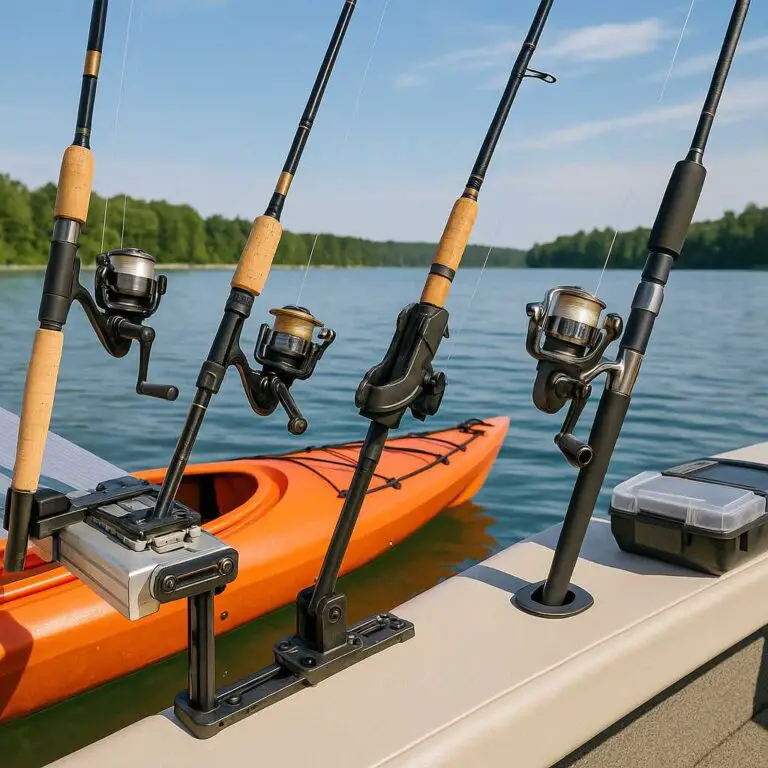The largemouth bass (Micropterus salmoides) is one of North America’s most iconic and sought-after freshwater game fish. Anglers from novice to expert cherish the thrill of catching this formidable species. However, to truly appreciate the largemouth bass, it’s essential to understand its life cycle, especially the fascinating process of spawning.
Let’s dive deep into the intricate details of largemouth bass spawning, from the environmental triggers to their reproductive habits, and offer insights into the factors affecting their populations.
Understanding the Largemouth Bass
Before we dive into their spawning habits, let’s briefly explore what makes the largemouth bass so intriguing. Largemouth bass are known for their distinctive appearance, characterized by a large mouth that extends past the eye. They have a greenish to olive-brown coloration with a lateral line running down their sides.
Largemouth bass are opportunistic predators, feasting on a variety of prey, including fish, insects, and smaller aquatic animals. Their voracious appetite and aggressive nature make them a favorite target for anglers.
Largemouth Bass Spawning Season
Largemouth bass spawning is a remarkable phenomenon that occurs during a specific season. The timing of spawning is crucial to ensure the survival of the young bass. Typically, largemouth bass spawn in the spring, but the exact timing can vary depending on location and water temperature.
The spawning season usually begins when water temperatures reach around 60-70°F (15-21°C). In colder regions, this may occur later in the spring, while in warmer climates, it can start earlier. Water temperature serves as a critical environmental trigger, signaling the bass to begin their reproductive activities.
Selecting Suitable Spawning Sites
Largemouth bass are meticulous when it comes to selecting suitable spawning sites. These sites are chosen based on specific criteria that ensure the survival of their offspring. Here are some factors that influence their choice:
1. Water Depth: Largemouth bass prefers relatively shallow waters for spawning, typically in depths of 2-6 feet (0.6-1.8 meters). These shallower areas provide a stable environment for the eggs and fry.
2. Vegetation: Aquatic vegetation, such as submerged grasses and lily pads, is a favorite choice for largemouth bass. These plants provide cover and protection for their eggs and fry from predators.
3. Clear Water: Largemouth bass prefer clear water for spawning, as it allows them to guard and protect their nests more effectively.
4. Substrate: They typically lay their eggs on firm substrates like rocks, gravel, or sand. This helps anchor the eggs and prevents them from being washed away.
The Spawning Process
Largemouth bass spawning involves a series of intricate behaviors and interactions between males and females. Here’s a step-by-step breakdown of the spawning process:
1. Courtship: The courtship ritual begins when male largemouth bass search for suitable nesting sites and prepare them by clearing away debris and vegetation. Once the nest is ready, males become more territorial and aggressive, chasing away other fish.
2. Female Arrival: Females are attracted to the nests by the males’ courtship displays. The female selects a suitable mate based on the quality of the nest and the male’s ability to defend it.
3. Egg Laying: After the female selects a mate, she releases her eggs, which are fertilized by the male as they are laid. The male guards the nest, protecting the eggs from potential threats.
4. Nest Guarding: Male largemouth bass are highly protective of their nests. They will aggressively defend the eggs from predators, including other fish and even diving birds. This protective behavior continues until the eggs hatch.
5. Hatching: Largemouth bass eggs typically hatch within 5-10 days, depending on water temperature. Once hatched, the fry remain in the nest for a few days until they absorb their yolk sacs and are ready to swim and feed independently.
Environmental Factors Affecting Spawning
Largemouth bass spawning is highly sensitive to environmental conditions, and various factors can impact their reproductive success. Here are some key environmental factors that can affect largemouth bass spawning:
1. Water Temperature: Sudden fluctuations in water temperature can disrupt the spawning process. Cold snaps or unseasonably warm weather can confuse bass and affect their timing.
2. Water Quality: Poor water quality, including high levels of pollutants or sedimentation, can be detrimental to largemouth bass eggs and fry.
3. Habitat Destruction: The destruction of essential spawning habitats, such as wetland areas and aquatic vegetation, can reduce the availability of suitable sites for largemouth bass.
4. Predation: Predators, such as birds and other fish species, can pose a significant threat to largemouth bass eggs and fry if not adequately protected by the male bass.
Nest Abandonment
In some cases, largemouth bass may abandon their nests. There are several reasons why this might occur:
1. Nest Disturbance: If the nest is repeatedly disturbed by other fish or human activity, the male bass may abandon it, as he cannot effectively protect the eggs.
2. Environmental Stress: Extreme weather events, such as heavy rainfall or sudden temperature changes, can lead to nest abandonment.
3. Female Desertion: If the female loses interest in the male or becomes stressed during the courtship, she may leave the nest, leading the male to abandon it as well.
4. Disease or Injury: If either the male or female becomes injured or falls victim to disease during the spawning process, they may abandon the nest.
Largemouth Bass Reproductive Success
The reproductive success of largemouth bass is a critical factor in maintaining healthy populations. Several aspects contribute to their reproductive success:
1. Nest Site Availability: Adequate and suitable nesting sites are essential for successful reproduction. Conservation efforts often focus on protecting and restoring these habitats.
2. Parental Care: The aggressive defense of nests by male largemouth bass is crucial for the survival of their offspring. This parental care ensures that eggs and fry have a better chance of reaching maturity.
3. Habitat Preservation: Protecting the natural habitats of largemouth bass, including clean water and aquatic vegetation, is essential for their long-term reproductive success.
4. Fishing Regulations: Implementing catch and size limits, as well as seasonal restrictions, helps protect spawning bass and ensures that a healthy population can continue to reproduce.
Largemouth Bass Lifespan
To fully appreciate the life cycle of largemouth bass, it’s essential to understand their lifespan. Largemouth bass can live for 10-16 years or more under ideal conditions. However, many factors, including predation, disease, and angler harvest, can impact their longevity.
Largemouth bass typically grow rapidly during their first few years of life, with the growth rate slowing as they age. Their size is influenced by factors such as food availability and habitat quality. In some cases, particularly in nutrient-rich waters, largemouth bass can reach impressive sizes, exceeding 20 inches (50 cm) and weighing several pounds.
Fishing for Largemouth Bass During Spawning Season
Fishing for largemouth bass during their spawning season can be a contentious issue among anglers and fisheries management. While it’s certainly possible to catch bass during this time, it’s essential to exercise responsible angling practices to minimize the impact on spawning fish:
1. Catch and Release: Consider catch and release practices during the spawning season to ensure that mature bass can complete their reproductive cycle.
2. Avoid Disturbing Nests: Be mindful of nesting areas and avoid disturbing them. Do not wade through or fish directly over active nests.
3. Handle Fish Carefully: Handle bass with care, using proper techniques to minimize stress and injury when catching and releasing.
4. Follow Local Regulations: Familiarize yourself with local fishing regulations, as some areas may have specific rules in place to protect spawning bass.
Conservation Efforts for Largemouth Bass
Conservation efforts play a vital role in preserving largemouth bass populations and their habitats. Here are some of the initiatives aimed at protecting these iconic fish:
1. Habitat Restoration: Restoration projects focus on enhancing and protecting crucial spawning habitats, such as wetlands and aquatic vegetation.
2. Water Quality Improvement: Efforts to reduce water pollution and sedimentation help maintain suitable environments for largemouth bass.
3. Fisheries Management: Sustainable fisheries management practices, including size and bag limits, are implemented to ensure that bass populations remain healthy.
4. Public Awareness: Educating anglers and the public about responsible fishing practices and the importance of largemouth bass conservation is essential for their long-term survival.
The Role of Citizen Scientists
Citizen scientists can contribute significantly to the understanding of largemouth bass and their spawning habits. By participating in data collection and reporting, anglers and nature enthusiasts can help researchers gather valuable information about bass populations, spawning behaviors, and habitat conditions.
Conclusion
The life cycle of largemouth bass is a fascinating journey, from the careful selection of spawning sites to the protective behavior of males guarding their nests. Understanding the intricacies of largemouth bass spawning is not only essential for anglers but also for the conservation and preservation of this iconic species.
As we continue to appreciate and enjoy the thrill of catching largemouth bass, let us also embrace our responsibility to protect their habitats, practice responsible fishing, and contribute to the conservation efforts that ensure these remarkable fish remain a symbol of North America’s freshwater ecosystems for generations to come.
Here is another great article to read about the largemouth bass.








